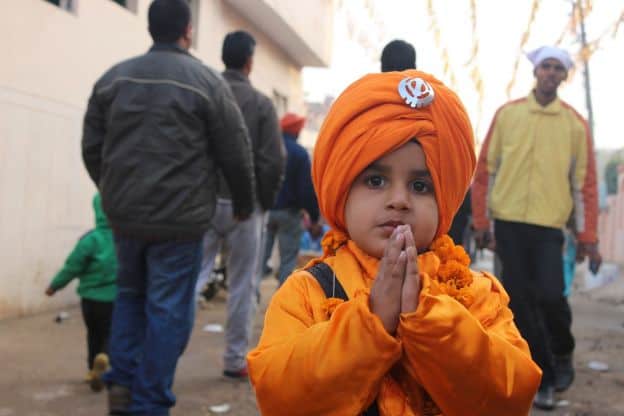Where the rivers Ravi, Chenab, Sutlej, Jhelum, and Beas run in the north of the Indian subcontinent, the lilting tones of the Punjabi language flow like melodies weaving through the centuries.
Perhaps you’ve heard the call from the Punjab, the “Land of the Five Rivers,” to learn to speak this ancient tongue. Maybe you’re traveling to the Punjab, doing business there, or just wanting to speak with family and friends around the world in their native language.
Start learning Punjabi history, scripts, and grammar, explore top resources, study guides, and tips. Discover the fast, easy, and best way to learn Punjabi now.
- About the Punjabi Language: Western and Eastern Punjabi
- How to Learn Punjabi: Hacking Punjabi for English Speakers
- What's the Best Way to Learn Punjabi?
- What's the Easiest Way to Learn Punjabi?
- How Long Does it Take to Learn Punjabi?
- How to Learn Punjabi Fast
- How to Speak Punjabi?
- Your Plan for Learning Punjabi
- Other Local Media Resources for Punjabi
Whatever your motivation for learning Punjabi, we’ll explore many resources that you can use to study and master it.
First, let’s discover more about the history and characteristics of this unique Indo-European language.
About the Punjabi Language: Western and Eastern Punjabi
In some ways, Punjabi is a language divided.
The Indian-Pakistani border denotes the distinction between Western Punjabi, spoken in Pakistan’s Punjab province, and Eastern Punjabi, spoken in the Indian state of Punjab.
Western Punjabi
Ethnic Punjabis comprise half to three-quarters of the Pakistani population. The Western standard of Punjabi, sometimes called Lahnda or Shahpur, is a majority language.
Yet, in Pakistan, the Punjabi language is sometimes seen as inferior.

Although spoken as a native language by millions in Pakistan, Punjabi has no official legal status there. English and Urdu serve as the country’s two official languages. Urdu, the first language of the Pakistani élite — about 8% of the population — was considered a “power language” for people wanting to advance in society.
Nonetheless, some argue that Punjabi — with its much larger number of native speakers — ought to have been selected as a national language in Pakistan. There is now a growing movement to make Punjabi language education mandatory in the Pakistani education system.
Eastern Punjabi
In the Indian state of Punjab, Punjabi is the official language. Per the 2011 census, Eastern Punjabi has about 36 million speakers, most of whom speak it as a first language.
Once Punjab became a separate Indian province, the government supported Punjabi-language education, and Punjabi media flourished. This strengthened the perception of Punjabi as a distinct language.
Yet, just as in Pakistan, there is some concern for the continued use and survival of Punjabi in India.

In certain contexts — such as state employment screenings or within private schools — Punjabi is being overshadowed by English. Even the Chief Minister and the governor in Punjab have been using English to address the people of their state, 90% of whom speak Punjabi. Charanjit Singh Channi, who heads the Ministry of Technical Education and Industrial Training in Punjab, is promoting a resolution in the Punjabi legislature to make the Punjabi language compulsory throughout the school system.
Eastern Punjabi is also spoken in Haryana, West Bengal, and Delhi.
Linguistic Influences on Punjabi
From Darius the Great’s occupation of the Indus River Valley during the time of the Achaemenid Empire in 515 BC to the later Muslim conquests in the 10th century AD, both Old Persian, and Arabic have contributed greatly to the Punjabi language — even more than the later influences of Greek and Turkish, Japanese and Portuguese, English and Chinese.

Differing histories in each country have produced a variance in cultural and linguistic influences. Indian (Eastern) Punjabi has adopted many words of Sanskrit origin, with a smattering of Arabic-influenced words. Western Punjabi is heavy on Persian and Arabic linguistic influence, without the imprint of Sanskrit.
The Majhi dialect of Punjabi is a standardized form of the language, common to both Pakistan and India. (This is not to be confused with the Majhi language, spoken primarily in Nepal.)
Punjabi Around the World
Today, between 100 million and 125 million people around the world speak some form of Punjabi. It’s among the top five languages spoken in the UK and Canada and among the top thirty languages spoken in the US.
Punjabi speakers in Pakistan greatly outnumber those in India. Yet, due to the language’s lack of official status in Pakistan, it’s much harder to find learning resources for Western Punjabi.
If you’re looking to learn Punjabi as an English speaker, you’re much more likely to run across resources for learning the Eastern (Indian) standard of the language.

Due to this bias, most of the resources mentioned in this post will be for Eastern Punjabi learners — although we will certainly discuss available Western Punjabi resources. If there are other Western Punjabi resources that we should include, please let us know in the comments section!
How to Learn Punjabi: Hacking Punjabi for English Speakers
The Eastern standard of Punjabi has incorporated some English loanwords, which may help English speakers trying to learn that form of Punjabi.
Nonetheless, the many differences between English and Punjabi might trip you up.
Challenges of the Punjabi Language
Let’s examine a few potential snags for Punjabi learners — especially those who are native English speakers.
If you’d like a deeper dive into this topic, this thesis provides an in-depth understanding of the differences between Punjabi and English grammar.
Punjabi Scripts
The two different standards of the Punjabi language are represented in writing by two very different scripts.
Shahmukhi: “From the Mouth of the Shah”

Western Punjabi, spoken primarily by Muslims in Pakistan’s Punjab region, uses the Shahmukhi script — a right-to-left script derived from the Nastaʼlīq script used to write in Arabic.
Gurmukhī: “From the Mouth of the Guru”
In the Indian state of Punjab, the Gurmukhī script is generally used by the Sikh population to write Eastern Punjabi. Gurmukhī comes from the Devanāgarī scripts used in northern India. (Hindus who speak Punjabi tend to write it in Devanāgarī.)
Like the English alphabet, Gurmukhī is written left-to-right.
Gurmukhī can be somewhat simple to learn because each letter only makes one sound — unlike English, where the same letter can make more than one sound, or more than one letter can make the same sound.
Grammatical Gender
Punjabi uses grammatical gender for improper nouns. This is not normal for English speakers.
In Punjabi, adjectives must be either feminine or masculine, depending on the nouns they modify.
There are a few rules of thumb for distinguishing noun genders. Many of them are based on the endings of singular nouns.
Lexical Tone
Like Mandarin or Cantonese, Punjabi is a tonal language. The vocal inflection placed on different syllables in Punjabi words can change the words’ meaning.
There are a number of different Punjabi dialects, each of which has its own tonal characteristics. Most Punjabi dialects have at least three tones, which are generally described as “low/rising,” “middle/medium,” and “high/falling.”

Tonal languages can be particularly tricky for English speakers. Although we use syllable stress to change meaning in English, we don’t change the pitch of individual syllables or words to change meaning, the way tonal languages do.
Declensions in Punjabi
Punjabi declines nouns, altering their form to change their meaning.
For instance, Punjabi uses a vocative case that changes nouns to indicate that someone is being directly addressed. (English uses the “direct address” or “vocative” comma for this function.)
Punjabi words often use a suffix to indicate qualities such as the number of something, its gender, or its case. (This is sometimes called “inflection.”)
Postpositions
Instead of prepositions that precede nouns, Punjabi uses postpositions.
Most Punjabi nouns followed by postpositions must be declined in the oblique case.
Word Order
Some of the word order in Punjabi may seem odd to English speakers.
Rather than the Subject-Verb-Object pattern normally found in English, Punjabi uses a fairly strict Subject-Object-Verb word order.

Polite Forms in Punjabi
Similar to vous in French (which is both the plural and formal form of “you”), Punjabi can use the same pronoun for both the formal/polite form and the plural form.
What’s the Best Way to Learn Punjabi?
Immerse Yourself
Surround yourself with Punjabi content such as movies, music, and books. This helps you get used to the sounds and rhythm of the language.
Use Language Apps
Use language learning apps like Duolingo, Rosetta Stone, or Babbel, which often have Punjabi courses. These apps are designed to make learning interactive and fun.
Online Courses
Explore online platforms that offer Punjabi courses. Websites like iTalki, Preply, and Udemy have tutors who can provide personalized lessons.
Language Exchange
Find a language exchange partner who speaks Punjabi. Platforms like Tandem or HelloTalk connect language learners for mutual exchange.
What’s the Easiest Way to Learn Punjabi?
There are no quick fixes to learning Punjabi, but the most fun (and so seemingly easiest) methods you can use are:
Watch Punjabi Videos
Watch Punjabi videos with subtitles to understand context, pronunciation, and sentence structure.
Punjabi Word Games
Create or find Punjabi word games such as crossword puzzles, word searches, or Scrabble with Punjabi words. This not only reinforces vocabulary but also adds a playful element.
Story Building
Collaboratively build a story with other Punjabi learners. Each person contributes a sentence or two in Punjabi, creating a collective and entertaining narrative while enhancing language skills.
How Long Does it Take to Learn Punjabi?
There are various estimates of how long it takes to learn Punjabi, ranging from 600 hours to 1100 hours. While it’s difficult to pin down an exact number of hours you will need to dedicate to the language, expect to spend around 600 hours to gain a working proficiency in the language, and over 1000 hours to gain fluency.
The time it takes to learn Punjabi depends on various factors, including your previous language learning experience, the amount of time you dedicate daily, and the resources you use.
How to Learn Punjabi Fast
Learn the Alphabet
Familiarize yourself with the Gurmukhi script, which is used for writing Punjabi. Knowing the script will aid in reading and writing and will mean you can pick vocabulary up faster as you won’t need to go through your native alphabet.
Use Flashcards To Memorize Vocabulary
Create flashcards to memorize Punjabi vocabulary. These might be physical flashcards or digital ones with tools such as Anki. Consistent practice will help expand your word bank quickly.
Spaced Repetition
Spaced repetition is highly effective for learning Punjabi as it optimizes the review of language concepts at intervals, reinforcing memory and aiding in long-term retention. By strategically spacing out exposure to Punjabi vocabulary and grammar rules, spaced repetition enhances the efficiency of learning and helps learners steadily build a solid foundation in the language.
How to Speak Punjabi?
It is important to regularly practice speaking Punjabi, even if it’s just repeating phrases or talking to yourself. This helps improve your pronunciation and fluency. To do this, it’s a good idea to engage with Punjabi-speaking communities online or in person. This could be forums, social media groups, or local cultural events. Any opportunity you have to speak Punjabi (with either native speakers or fellow learners) will help to improve your speaking skills.
Your Plan for Learning Punjabi
As with any complex endeavor, you will more likely succeed at learning Punjabi if you start by making a plan.
Decide on Your Goals
You’ll approach your studies in a different way if you’re learning more formal Punjabi for business or learning “survival Punjabi” for travel. If you’re trying to get more fluent to connect to family and friends, your approach will be different than someone who’s going to study in Punjab.
You can further refine your learning goals based on whether you’re a complete beginner, an intermediate learner with rusty Punjabi, or an advanced learner who is trying to reach native-level fluency.
Figure Out Your Timeframe
Your learning goals may not be bound by a specific timeframe.
On the other hand, you might already have a trip planned, or have family coming to visit soon from the Punjab. In these cases, mark your calendar with projected learning milestones. To achieve the desired level of fluency on time, you’ll need to commit to a study schedule.

Pick an Approach
Based on your learning goals, the type of Punjabi you want to learn, and your timeframe (if any), you can decide on a learning approach that will best suit your needs.
While you’re planning, take your own personal preferences into consideration. If you know your learning style, use that information to choose resources that will accelerate your learning.
Think back to your own educational experiences. What kind of learning did you most enjoy? Was it lectures? Videos or other presentations with a lot of visual content? Did you prefer reading and then applying your knowledge through exercises?
We’ll be looking at a plethora of different Punjabi learning resources in the next section. Start with the ones that most appeal to you. After all, you have a long learning journey ahead of you — you don’t want it to be a drag from the very beginning. Begin with something you find fun or exciting, whether it’s word games, an interactive app, or a series of comical videos about basic Punjabi.
Keep Yourself on Track
Learning the basics of a new language — especially one that’s somewhat different from your native language — is a process that takes many months. And that’s just the beginning.
A language journal can help you stay on the right track. Update it regularly — but don’t make it a burden.
Practice writing in your chosen Punjabi script. Record new words and review old ones. Look back periodically at older entries to see how far you’ve come.

Let yourself do free writing in your language journal: Puzzle over what you don’t understand about Punjabi. Air your frustrations. Evaluate your learning process.
If a language journal isn’t your cup of tea, consider recruiting an accountability partner. While it would be helpful if your partner is also learning Punjabi, it’s not mandatory. Check in regularly with each other to make sure you’re each meeting your goals. An accountability partner can also be a great source of support when you’re discouraged — or simply tired of studying.
To avoid learning burnout, keep study sessions short. It’s better to do ten or fifteen minutes a day than four hours, once a week.
If you are under time constraints and have to learn Punjabi more quickly, think of creative ways to keep yourself interested.
Review, Reconsider, and Remix
As you learn Punjabi, you’ll go through many phases. Apps or exercises that delighted you when you started out might start to get on your nerves after a few months.
It’s important to review your progress and reconsider your learning options every few weeks or months. Take a break from some learning resources, and add some new ones to the mix.

Varying your learning resources and tasks does more than maintain your interest in learning Punjabi: When you’re learning a living language, you’ll want to immerse yourself in as many different resources as possible so you’ll learn more of the language — everything from basic vocab and grammar rules to slang and specialized vocabulary. Even if you only concentrate on a small handful of resources at a time, it’s important to expose yourself to a broad range of resources — like the wide variety of Punjabi learning tools we’re about to explore.
Other Local Media Resources for Punjabi
To be more familiar with how Punjabi is used in other registers and how it sounds in different contexts, you need to explore authentic Punjabi resources. Punjabi texts, websites, radio, TV, film, and music are some great supplementary resources to explore.
Punjabi Websites and Blogs
For families with young children studying Eastern Punjabi, the SikhVille.org site has varied resources. These include word game downloads, lessons on constructing Punjabi sentences, and Punjabi videos about Sikh culture. The site also links to related apps for Android and iOS; these apps were developed by its sponsor, Vismaad.
The Academy of the Punjab in North America (APNA) hosts a website offering content for learners of both Western and Eastern Punjabi. The APNA site features interviews and articles, as well as research papers, in the Shahmukhi script for intermediate and advanced Western Punjabi learners.
Singer and poet Pashaura Singh Dhillon’s site has both Eastern Punjabi and English-language content. He blogs about music, poetry, and other cultural topics.
While not a Punjabi language blog, this article on Punjabi culture from the Pakpedia site will introduce you to the music and literature of Western Punjabi. You’ll learn about famous Punjabi writers, poets, singers, and other artists, whose work can enrich your Punjabi learning adventure.
Punjabi Newspapers and Magazines
Here is a brief list of online Punjabi newspapers and magazines.
Eastern Punjabi Periodicals
- Ajitlandhar (Jalandhar, India)
- Punjab Express (Italy)
- Punjabi Tribune (Chandigarh, India)
- Sky Hawk Times (Mohali, India)
Western Punjabi Periodicals (based in Pakistan)
Punjabi Books
While perhaps not as exciting as videos or interactive apps, textbooks provide thorough explanations of grammar, sentence structure, and vocabulary that you can absorb completely at your own pace.
An Introduction to Punjabi: Grammar, Conversation, and Literature by Gurinder Singh Mann is a foundational text that’s highly recommended by YouTuber Stephen Gucciardi. It focuses on Eastern Punjabi, using the Gurmukhī script.

This book is difficult to find as a hard copy. As of this writing, it’s unavailable on Amazon. However, it’s available for download or online reading through the Sikh Book Club website. (Signing in using your Google account may present technical difficulties. You can easily create a free account on the Sikh Book Club website to gain access to this and other resources.)
The Sikh Book Club has other free-of-charge Eastern Punjabi learning materials, such as:
- Readwell’s Learn Punjabi in a Month by Bhai Ishwar Datt (Indian Language Series)
- Gurmukhī Giān: Come To Learn Punjabi by Dr. Satnam Singh Sandhu
- Learn Punjabi in 25 Days by Bhai Santokh Singh
Several of these textbooks include Gurmukhī writing practice, language writing exercises, and Punjabi reading exercises.
These textbooks are part of an extensive online catalogue of Punjabi books available from Sikh Book Club. These free books can be read online, downloaded as PDFs, or printed out.
Punjabi Books for Intermediate and Advanced Learners
Intermediate learners of Eastern Punjabi can get reading practice through these simple children’s stories from SikhVille.org.
Learners of either Western or Eastern Punjabi can enjoy Gurmeet Kaur’s . This book teaches about the entire Punjabi region with text in Gurmukhī, Shahmukhi, and English.
For learners of Western (Pakistani) Punjabi, the Academy of the Punjab in North America has a collection of free Shahmukhi e-books, as well as Shahmukhi magazines.
Advanced learners may find some value in the free ebook downloads from LearnPunjabi, sponsored by Punjabi University in Patiala. These offerings include phonetic and IPA transcriptions of Eastern Punjabi texts (with translations), an Encyclopedia of Punjabi Language and Culture, and several volumes of verse.

The Sooherang Punjabi Bookstore has tiered plans, paid and unpaid, that give members access to various Eastern Punjabi books and ebooks.
Although a few dozen books are currently available to read online, only four of them are accessible through a non-paid account. That said, the membership prices are fairly modest. As of this writing, you can have a paid annual membership for as low as $2 per month.
In order to get access to any of Sooherang’s e-books, even the free ones, you’ll need to register on the site.
Punjabi Dictionaries
LearnPunjabi.org has an interactive online Punjabi-English Dictionary. You can search for words via Gurmukhī, Shahmukhi, or English meaning. (There’s a virtual onscreen keyboard that you can use to type in Shahmukhi or Gurmukhī script.)
Amazon has a few Eastern Punjabi dictionaries, available as print books:
- Student’s English-Punjabi Dictionary by Gurkirpal Singh Sekhon
- Punjabi-English/English-Punjabi Dictionary & Phrasebook by Manmohan Kaur (includes a pronunciation guide, plus categorized words and phrases)
- English-Punjabi and Punjabi-English Word-to-Word Bilingual Dictionary (Punjabi and English Edition) by Wahab Translations
The English Punjabi Dictionary (Seventh Revised Edition) by Punjabi University is available through the Sikh Book Club. Like the dictionaries available on Amazon, it’s for Eastern Punjabi.
If you’d like a mobile dictionary app for Eastern Punjabi, the Punjabi Dictionary by Kulpreet Chilana may be a good choice for you. Unfortunately, it’s only available for iOS at this time.
Punjabi Radio
California-based Punjabi Radio USA broadcasts in Eastern Punjabi on the West Coast of the U.S. You can also stream the station online, or listen to it on a mobile app.
From elsewhere in the Punjabi diaspora comes Panjab Radio. It’s broadcast from the UK, and available online and through mobile streaming apps.
Online Radio Box streams numerous Eastern Punjabi stations from India and around the world.

From the Pakistani Punjab, Online Radio Box offers streaming from about twenty stations.
Punjabi Television
Several of the major subscription services bring Punjabi programming — mostly from India — right into your living room:
- Dish Network’s Punjabi TV packages
- Punjabi TV packages on Sling TV
- World Punjabi and Mehak Punjabi TV on Roku
Coming from Canada, Apna Punjab broadcasts a variety of Eastern Punjabi programs, which you can access online.
AjitTV streams Eastern Punjabi programming online from its website.
Google Play has a Punjabi TV and Movies Online app for Android devices.
Punjabi Music
Punjabi music is available in many styles and can add energy and spice to your language studies. A YouTube search for “Punjabi pop music” will yield pop, dance, rap, and hip-hop, among other types of songs.
Here are but a few genres of Punjabi music.
Sufi and Folk Music
TheSufi.com has a large collection of both Sufi and Punjabi folk music. You can download over 6,000 songs in MP3 format, ensuring hours of Punjabi listening.
Bhaṅgṛā
With roots in the Punjab and popularized by the Punjabi community in Great Britain, Bhaṅgṛā music is a favorite within the Punjabi diaspora. A fusion between traditional Punjabi folk music and Western musical instruments of the 20th century, Bhaṅgṛā music is even finding a place in Bollywood films.
You can hear Bhaṅgṛā music on TuneIn.com, as well as on the Soundcloud’s Bhaṅgṛā selection.
The APNA site features an extensive collection of both Sufi and folk music, plus Punjabi pop and Bhaṅgṛā music.
Punjabi folk singer Pashaura Singh Dhillon has audio downloads of his music on Bandcamp. Try his YouTube channel for “moving image slideshows” of his songs, with English subtitles.
Punjabi Movies
For popcorn-powered Punjabi learning, check out these sources for cinematic curriculum:
Tech tip and review site Tekkibytes, from Kolkata native Soumik Ghosh, features a list of Punjabi movie download sites.

Streaming service Netflix has a tremendous amount of Punjabi-language content. You’ll find movies and television shows in several genres, including romance and comedy. Netflix generally gives you many options for audio and subtitle control, so you can probably set these for Punjabi audio with English subtitles to start. As you progress in your knowledge of the language, you can switch to Punjabi audio with Punjabi subtitles — and then, perhaps, drop the subtitles altogether when you reach an advanced phase of your learning.
Punjabi links India and Pakistan through hundreds of years of history. It’s the language of a colorful culture that’s been embraced by Bollywood and spoken throughout the world.
Whether you learn this lyrical language for travel or business, or to connect to friends and family, becoming a fluent Punjabi speaker is a tremendously rewarding experience.

